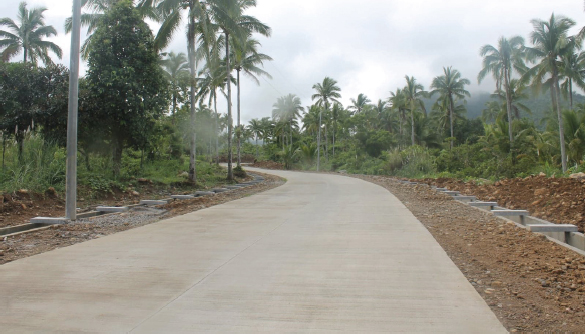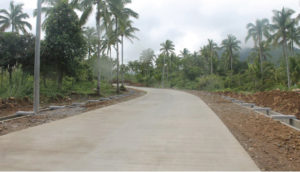CARIGARA, Leyte- The Department of Public Works and Highways-Leyte Second District Engineering Office allocated a total of P85 million for the construction of a concrete road leading to Villaconzoilo Agri and Ecotourism Farm and Silawa Falls, both in Burauen town.
The project involves 3.5 kilometers with the width of 6.1 meters and thickness of .028 meters, including culverts, excavation and embankment.
District Engineer Carlos Veloso said that the project will provide convenient access for visitors who want to experience the natural forest atmosphere and the relaxing effect of the cool and clean waterfalls.
He added that this development will also open new opportunities to the community through the new income generating programs that will contribute to the growth of its economy.
At present, the road to Villaconzoilo Agri and Eco-Tourism Farm, located in Barangay Villaconzoilo, is now accessible.
However, the road leading to Silawa Falls, also located in the same village about seven kms away from the town center, is still underway.
Meanwhile, the Payapa at Masaganang Pamana (Pamana) has funded about P 9.85 million in addition to the road concreting works at Villaconzoilo leading to Silawa Falls.(LIZBETH ANN A. ABELLA)
DPWH opens road leading to a farm tourism site, waterfalls in Leyte
Tacloban young cancer warriors receive early Christmas gifts from various groups

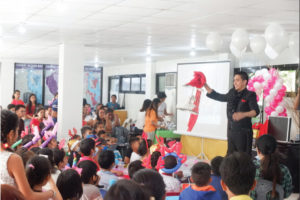
TACLOBAN CITY-At least 39 children with cancer together with their siblings and families received their early Christmas gifts from various groups on Sunday (December 9).
The event was led by the Tingog Sinirangan party-list and joined by Philippine Toy Library, thanked Sirakwaraynon Eagles Club, Tacloban City Eagles Club, Lions International, Share Your Spare Singapore, Tacloban City Sangguniang Kabataan Federation president Thomas Diaz, and other individuals who collaborated with them for the event.
“This is our fourth party with them since April 2017. We give them two parties every year–the Summer Fun and Christmas Party,” said Bunny Culibar-Celebrado, the youth chairperson of Tingog Sinirangan party-list.
“We also give gifts to the siblings because we don’t want them to feel like they’re left behind. We understand that parents usually poured most of their time to their child who is a patient,” Celebrado added.
During the party, dubbed as “Winter Wonderland Christmas,” the children were entertained by magicians and showered with toys, gifts, balloon twist, and a bubble show.
Some children also performed special numbers for their parents and visitors. Also present were cancer-free children and the families and siblings of patients who already passed away.
“This is our thanksgiving program. We want our children to be always happy and remain positive,” said Irene Sudario, a parent.
The 39 young cancer warriors are under Dr. Joy Tobio of the Pediatric Oncology Ward at the Eastern Visayas Regional Medical Center.
She also thanked the Kids of the Kingdom Region 8, a pedia cancer and chronic illness support group in the city.
“We provide support group where children and their families are drawn close to God and get to know the promise of His words. Cancer steals, kills and destroys. But Jesus has come to give life and have it to the full,” it said.
According to the group, they provide a “safe haven for children fighting for chronic illness such as cancer.”
For support and donation to Kids of the Kingdom Region 8, text/call Dr. Joy Tobio, 0927 691 3706 or Charo Bajado, 0933 854 2878. (RONALD O. REYES)
Pagcor donates computers, TV sets to Leyte school
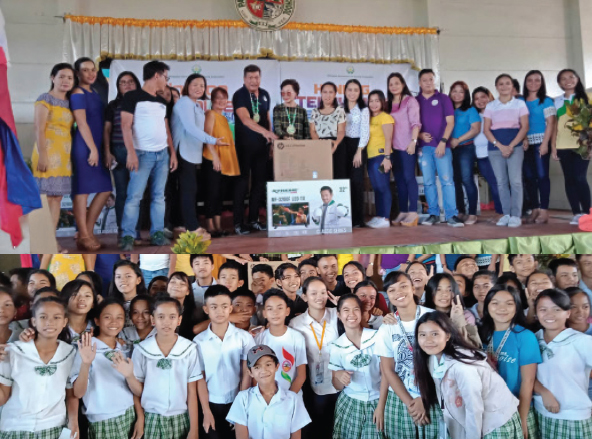
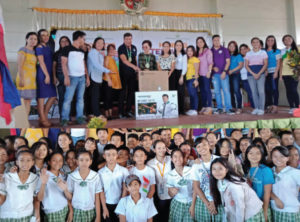
PALO, Leyte- The Palo National High School, this town, is the latest recipient of the “Handog Computer” program of President Rodrigo Duterte through the Philippine Amusement and Gaming Corporation (Pagcor).
On Friday (December 7), Pagcor, along with Palo Mayor Remedios Petilla, distributed 25 desktop computers and 10 32-inch LED televisions to the school.
“This is a big help for you to get an excellent education. Make the most out of these computers and be inspired in your studies,” Petilla told the students.
“It’s a blessing. After the 2013 super typhoon Yolanda we received six classrooms from Pagcor, and now they’re back for more assistance to us,” added Estrellita Morano, the school principal.
Morano reiterated her gratitude to Petilla, who was also the former Pagcor vice-president during the administration of then President Gloria Macapagal-Arroyo.
“It was Mayor Petilla who endorsed the request of our school through the initiative of our two teachers Belen Manasis and Cynthia Agner in 2017,” Morano added.
Rico Acuña, Pagcor’s senior community development and welfare officer, urged the school to use the computers and ensure its care for the next batches of students.
“We’re thankful to Pagcor. This is a big help to our studies,” said 15-year old student Jasper Buntog.
Douglas Macalalag, the president of the General Parents-Teachers Association, called the arrival of the computers as “a blessing.”
“We promise to take good care of these computers,” Macalalag told the Pagcor official.
Considered a “mega-school” in Leyte Division, Palo National High School has 4, 274 students and 144 teachers as of its current school year.
(RONALD O. REYES)
NMP holds earthquake and tsunami drill
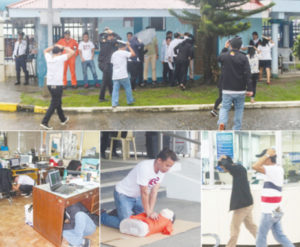
In a bid to elevate public awareness on how to respond in the wake of any emergency situations caused by natural calamities, such as earthquake and tsunami, the National Maritime Polytechnic (NMP) in partnership with the City Disaster Risk Reduction and Management Office (CDRRMO) of Tacloban City conducted an earthquake and tsunami drill participated by NMP trainees and employees on November 5, 2018 at the NMP Complex, Tacloban City.
The activity was held pursuant to the directive from the National Disaster Risk Reduction and Management Council (NDRRMC) relative to the conduct of CY 2018 4th Quarter Nationwide Simultaneous Earthquake Drill (NSED) and Observance of World Tsunami Awareness Day on 05 November 2018.
The drill started at around 10 AM with a one-minute siren which was meant to inform everyone inside the NMP premises that an earthquake has just occurred. All NMP trainees, employees, and guests do the “duck, cover and hold on.”
In an interval of 10 seconds, another one-minute siren was heard, a signal for everyone within the vicinity to evacuate the building and proceed to the designated mustering stations wherein a marshal will do the head count.
One “scenario casualty” was reported needing immediate medical attention. Using the NMP emergency vehicle, the search and rescue team was dispatched and was able to bring the casualty to a safe area where a cardio pulmonary resuscitation (CPR) was executed by the assigned First Aide, an NMP trainee.
After the casualty was revived, the third siren was alarmed for one minute in anticipation for an aftershock, tsunami.
Everyone was advised to proceed to the second floor of the NMP Administration Building having a higher elevation compared to other buildings in the area.
The exercise was terminated after the communication was established to the different responders identified by the team.
“This will help us prepare ourselves when a tsunami or an earthquake hits Tacloban City,” Mr. Eduardo V. Polo, Training Officer of Tacloban City CDRMMO said.
“It is our responsibility to ensure that everyone are aware and knowledgeable of the things that should be done in cases of emergencies,” he added.(PR)
Christmas Village in Tacloban projected to draw thousands of visitors
A 65-feet Christmas tree as its main attraction
TACLOBAN CITY- Thousands of people are expected to visit the city’s main plaza as it was transformed into a Christmas Village.
At the center of the Christmas Village is a 65-feet cone-shaped Christmas tree adorned with colorful lights and stars of various sizes.
Inside the park, the traditional bamboo stars perched in the lamp posts and the classic Nativity scene showing the birth of Jesus Christ could be seen and enjoyed by the public.
Of course, for those who are fond of taking photos, especially now in this age of ‘selfies,’ visitors could have their photo taken at a pictorial board of Sta. Claus.
Christmas carols could also be heard inside the Christmas Village which formally opened on Friday (Dec.7) to add the Christmas spirit.
The city government spent about P500,000 for this annual undertaking which has drawn big crowds since it was started.
Marilou Tabao, city tourism officer, said that the Christmas Village is open to the public all throughout the Christmas season which is to end on January 6, coinciding the celebration of the Three Kings or Epiphany.
Expected to grace the opening of the Christmas Village were Mayor Cristina Romualdez, councilors, department heads and employees of the city government.
For this year, the underlying theme of the Christmas Village is ‘Let Thousand Stars Shine’ symbolizing the city’s hope for a bright future.
(JOEY A. GABIETA)

